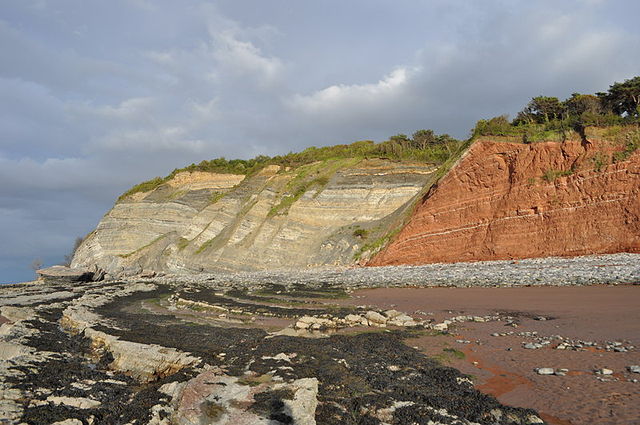 |
This is a file from the Wikimedia Commons. Information from its description page there is shown below.
Commons is a freely licensed media file repository. You can help.
|
Summary
| Description |
English: The Blue Anchor FaultPossibly the most obvious fault in Britain. The red rock with reduction horizons is Triassic Mercia Mudstone (MMS), to the left is Jurassic interbedded marls and muds (with evaporites like gypsum). You can tell this is a normal fault because the Jurassic strata is younger than the MMS. This means the Jurassic strata has slid downwards to sit beside the MMS. Also near the fault in the MMS the lighter reduction horizons are dipping downwards probably due to marginal drag. The line of the fault runs along the beach, shown by the rock/sand divide.
|
| Date |
9 June 2011 |
| Source |
From geograph.org.uk; transferred by User:Rubberstamp using geograph_org2commons. |
| Author |
Ashley Dace |
Permission
( Reusing this file) |
Creative Commons Attribution Share-alike license 2.0
|
|
Camera location
|
51° 11′ 4.02″ N, 3° 22′ 53.98″ W
|
This and other images at their locations on: Google Maps - Google Earth - OpenStreetMap |
( Info)51.184450;-3.381661 |
Licensing
 |
This image was taken from the Geograph project collection. See this photograph's page on the Geograph website for the photographer's contact details. The copyright on this image is owned by Ashley Dace and is licensed for reuse under the Creative Commons Attribution-ShareAlike 2.0 license. |
File usage
The following pages on Schools Wikipedia link to this image (list may be incomplete):
SOS Childrens Villages chose the best bits of Wikipedia to help you learn. SOS Children helps those who have nothing and no one, giving them back the famly they have lost and bringing them the very best opportunities for a happy, healthy future. You can help by sponsoring a child.



